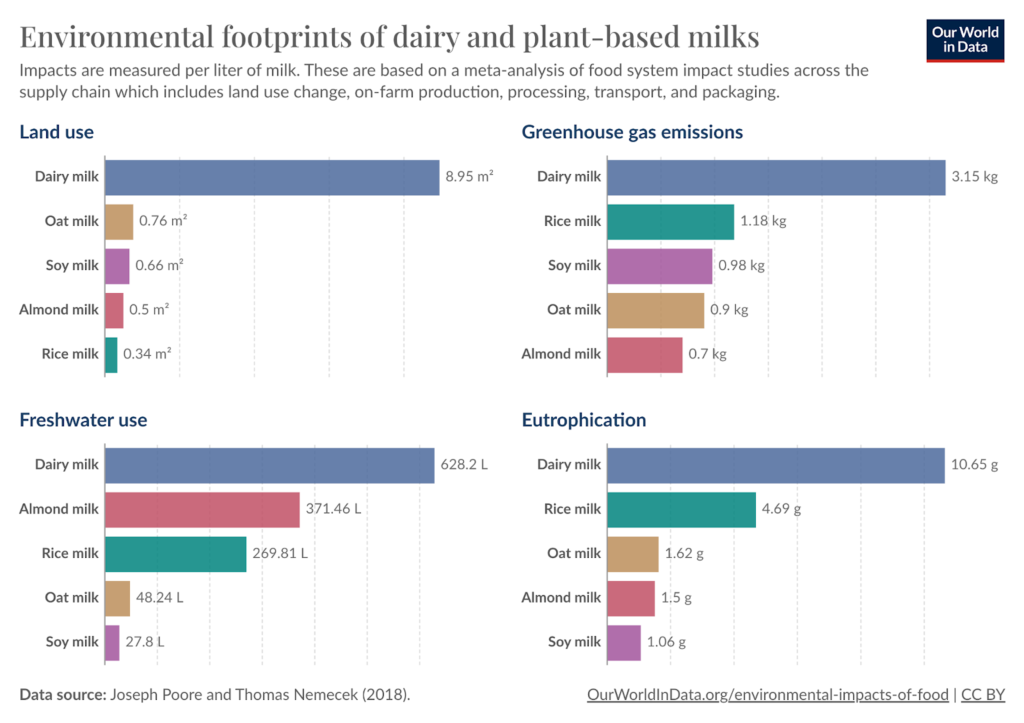Transitioning towards plant-based foods is a key factor in reducing our environmental footprint, leading to lower greenhouse gas emissions, reduced water usage and pollution, reduced land use and deforestation, as well as the potential to rewild land previously used for animal agriculture. A transition towards plant-based diets is a significant step towards biodiversity conservation and more sustainable land use, highlighting the importance of individual dietary choices in environmental sustainability.

The study Reducing food’s environmental impacts through producers and consumers by J. Poore and T. Nemecek (2018, updated 2019) from the University of Oxford, published in the journal Science, provided a comprehensive analysis of the environmental impact of agriculture. Key findings include:
Significantly negative environmental impacts from animal agriculture: “The impacts of animal products can markedly exceed those of vegetable substitutes to such a degree that meat, aquaculture, eggs, and dairy use 75%- 83% of the world’s farmland and contribute 56 to 58% of food’s different emissions, despite providing only 37% of our protein and 18% of our calories.” Reducing food’s environmental impacts through producers and consumers
Potential for Reduction: The study suggested that a shift towards plant-based diets could substantially reduce global greenhouse gas emissions. This reduction could be as much as 73% in scenarios where people adopt vegan diets.
The United Nations Environment Programme (UNEP), Chatham House and Compassion in World Farming launched in partnership, a Chatham House report Food system impacts on biodiversity loss | UNEP – UN Environment Programme which states that “Our global food system is the primary driver of biodiversity loss, with agriculture alone being the identified threat to 24,000 of the 28,000 (86%) species at risk of extinction. The global rate of species extinction today is higher than the average rate over the past 10 million years.”
“A reform of food systems is a matter of urgency and needs to focus on three interdependent actions:

Dairy milk production is associated with higher greenhouse gas emissions, land use, and water consumption compared to plant-based alternatives like soy milk. This makes plant-based milks a more environmentally friendly option. 4
Dairy farming, which involves cattle grazing and feed crop cultivation, requires approximately ten times the land needed for producing plant-based milk alternatives. Additionally, the process of producing cow’s milk is associated with 3 times more greenhouse gas emissions than plant-based milk. This is largely due to methane, a potent greenhouse gas, which is emitted by cows. Plant-based milks generate about a third of the greenhouse gas emissions compared to cow’s milk.5
Furthermore, cow’s milk production is significantly more water-intensive, requiring between two to twenty times more freshwater. This high water demand is linked to the water required for feed crop irrigation and cattle hydration. Lastly, cow’s milk production contributes to higher levels of eutrophication – the excessive richness of nutrients in bodies of water, often due to runoff from the land, which causes a dense growth of plant life and death of animal life from lack of oxygen. This phenomenon is exacerbated by the nutrient-rich waste produced in dairy farming. These environmental impacts highlight the sustainability advantages of plant-based milk alternatives.
With respect to soy milk, it is important to note that 95% of Brazilian soy is used for animal feed. Globally, more than three-quarters 6 of soy, by mass, is used for animal feed. The other main co-product is soybean oil. This means that very little of Amazonian land-use pressures from soy have been driven by crops for direct human consumption; most is for animal feed.
For precise figures and further details, you can refer to studies such as “Reducing food’s environmental impacts through producers and consumers” 1, 2 by J. Poore and T. Nemecek, published in Science which provides a comprehensive analysis of the environmental impacts of various food products, including dairy and plant-based alternatives. Additionally, the report from the Food and Agriculture Organization of the United Nations (FAO) Livestock’s Long Shadow 6 provides extensive data on the environmental impact of livestock farming, including dairy production.
References
1 https://www.science.org/doi/10.1126/science.aaq02161
2 https://josephpoore.com/Science%20360%206392%20987%20-%20Accepted%20Manuscript.pdf
3 https://www.unep.org/news-and-stories/press-release/our-global-food-system-primary-driver-biodiversity-loss
4 https://ourworldindata.org/environmental-impact-milks
5 https://ourworldindata.org/soy#more-than-three-quarters-of-global-soy-is-fed-to-animals
6 https://www.fao.org/3/a0701e/a0701e.pdf